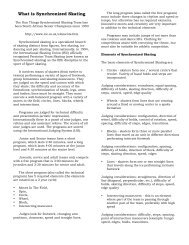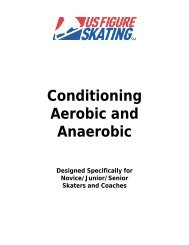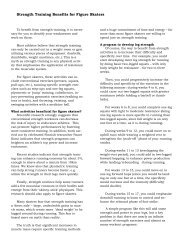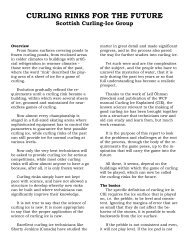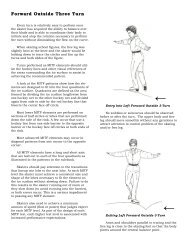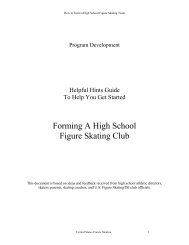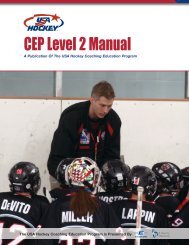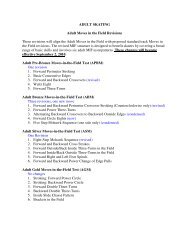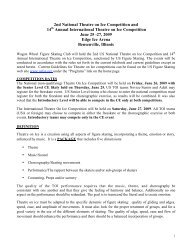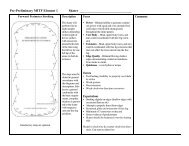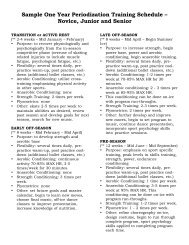Chapter 2 Learning Hierarchies - Ice skating resources
Chapter 2 Learning Hierarchies - Ice skating resources
Chapter 2 Learning Hierarchies - Ice skating resources
You also want an ePaper? Increase the reach of your titles
YUMPU automatically turns print PDFs into web optimized ePapers that Google loves.
<strong>Chapter</strong> 2<br />
<strong>Learning</strong> <strong>Hierarchies</strong> 3<br />
<strong>Chapter</strong> 2 (Pages 63 -- 84)<br />
<strong>Learning</strong> <strong>Hierarchies</strong>; Robert M. Gagné<br />
Robert M. Gagné<br />
This article builds upon the theory of cumulative learning<br />
that was described in the previous chapter. It blends<br />
theoretical explanations with the description of a practical<br />
analysis technique for designers to use when determining<br />
the appropriate content for a given piece of instruction.<br />
This work continues to reflect Gagné’s interest in school<br />
curriculum applications. <strong>Learning</strong> hierarchies, originally<br />
called hierarchies of knowledge, were not new to Gagné in<br />
1968; he had introduced them earlier in the 1960in his<br />
studies of the acquisition of knowledge. His work in this<br />
area is interesting in that it reflects an early departure from<br />
the behavioral orientation that was predominant. However,<br />
it was consistent with the emphasis on behavioral<br />
objectives and the systematic analysis of instruction, both<br />
of which were then considered quite innovative.<br />
A few years ago, in the course of studies of the learning of tasks resembling those<br />
learned in schools (Gagné, 1962), I used the term “learning hierarchy” to refer to a set of<br />
specified intellectual capabilities having, according to theoretical considerations, an<br />
ordered relationship to each other. It was possible, I stated, beginning with a clear<br />
statement of some terminal objective of instruction, to analyze this final capability into<br />
subordinate skills in an order such that lower-level ones could be predicted to generate<br />
positive transfer to higher-order ones. The entire set of ordered intellectual skills formed<br />
a hierarchy that was considered to bear some relation to a plan for effective instruction.<br />
An example of a hierarchy, pertaining to the addition of integers, is shown in Figure 2.1.<br />
In the framework of instruction in “modern math,” children learn two distinguishable<br />
terminal capabilities: one of these, shown on the right, is simply finding sums of positive<br />
and negative numbers; a second, shown on the left, constitutes a demonstration of the<br />
3 Editor’s Note: From Gagné, R. M. (1968). <strong>Learning</strong> hierarchies. Educational Psychologist, 6, 1-<br />
9. Copyright 1968 by Division 15, American Psychological Association. Reprinted by permission.<br />
This article was originally presented by Gagné at the Annual Meeting of the American<br />
Psychological Association, San Francisco, California, August 31, 1968. It was the presidential<br />
address that he presented as retiring president of Division 15 of the Association.
<strong>Chapter</strong> 2 (Pages 63 -- 84)<br />
<strong>Learning</strong> <strong>Hierarchies</strong>; Robert M. Gagné<br />
logical validity of adding any pair of integers, using the properties of the number system<br />
to effect this demonstration. For both these tasks, an analysis revealed a set of<br />
subordinate capabilities shown in the figure, some in common and some not in common,<br />
ranging down to some relatively simple skills which the children were presumed to<br />
possess at the beginning of their instruction.<br />
What I should like to do at this point is to tell you some things I have learned about<br />
learning hierarchies in the last couple of years. In part, these things have been learned<br />
by my research and the research of other people; and in part, from the various reactions<br />
I have received about them from many sources. I need to say, surely, that critical<br />
comments have most certainly caused me to rethink and clarify, at least in my own mind,<br />
what the nature, characteristics, and uses of learning hierarchies may be. Since such<br />
hierarchies contain elements of theory, I am most eager to alter or augment these<br />
elements to provide improved prediction, if that is possible. What I am likely to be most<br />
obstinate about changing, however, is the basic idea or the feasibility of predicting<br />
optimal sequences of learning events.<br />
Characteristics of <strong>Learning</strong> <strong>Hierarchies</strong><br />
What are the characteristics of a learning hierarchy How does one know when he has<br />
one, and what precisely can be predicted from it To find initial answers to such<br />
questions, one can review the kind of study which first gave rise to the idea. This was a<br />
study derived from an investigation of the learning of a task of constructing formulas for<br />
the sums of number series (Gagné, 1962). In the original study using programmed
<strong>Chapter</strong> 2 (Pages 63 -- 84)<br />
<strong>Learning</strong> <strong>Hierarchies</strong>; Robert M. Gagné<br />
instruction (Gagné & Brown, 1961), individual differences in learning from the program<br />
were of course highly evident. One could have attributed them to differences in<br />
“intelligence,” and let it go at that. But it seemed to me these differences in learning<br />
performance were more likely attributable to certain identifiable skills which were not<br />
directly represented in the program itself, but which were needed along the way in doing<br />
what the program demanded. They were activities that the learners could or could not<br />
do, and which the program was accordingly more or less successful in teaching them to<br />
do.<br />
The next step was to figure out what these “subordinate skills” might be. Beginning with<br />
the final task, I found it was possible to identify nine subordinate capabilities, related to<br />
each other in an ordered way, by successively asking the question concerning each<br />
task, “What would the individual already have to know how to do in order to learn this<br />
new capability simply by being given verbal instructions” It is probably of some<br />
importance to note that the kinds of capabilities identified in this manner did not directly<br />
pertain to number series, but rather included such skills as the following:<br />
a) Identifying the location of numerals in a tabular array by means of letters<br />
giving their row and column location<br />
b) Completing statements of equality by supplying missing numbers in<br />
equations containing mixed arithmetic operations<br />
c) Identifying the numbers or letters in a tabular array which formed certain<br />
spatial patterns represented by lines connecting at 90 degrees and 45<br />
degrees.<br />
I emphasize that the subordinate skills so identified are not related to number series in a<br />
logical sense; what they are related to, psychologically, is the kind of behavior the<br />
learner has to engage in if the learner is going to be successful at figuring out from a<br />
tabular array of number series properties, how to formulate an equation for their sum.<br />
Having identified a hierarchy of capabilities in this way, the next step was to test its<br />
validity. First, a test was made on a number of subjects to determine which of these<br />
subordinate tasks they already knew how to do. Two subjects could do all of the<br />
subordinate tasks but not the final one; two could do all but two; one all but three; and<br />
two all but four. Each of these learners was then taught to do whichever subordinate<br />
tasks he couldn’t initially perform. Then, having completed this learning, each was given<br />
verbal directions about how to do the final task, without any practice on it. Six out of<br />
these seven subjects then proceeded to execute the final task of making a formula for<br />
four number series, which he hadn’t seen before. Additional evidence showed that a<br />
similarly marked change in capability was brought about in these learners at each “level”
<strong>Chapter</strong> 2 (Pages 63 -- 84)<br />
<strong>Learning</strong> <strong>Hierarchies</strong>; Robert M. Gagné<br />
of the hierarchy for which instruction had been given.<br />
Certain patterns of responding to the tests of subordinate tasks also were revealed in<br />
this study. Specifically, those who got subordinate skill number 1 correct, also got all the<br />
skills lower in the hierarchy correct. Those who got number 2 correct, and missed<br />
number 1, got all the skills lower than number 2 correct also. In other words, in these<br />
seven learners, there was in fact an ordered relationship (similar to that displayed in a<br />
Guttman-type scale) 4 among the subordinate capabilities measured.<br />
On the basis of this brief review, I should like to consider the question of what a learning<br />
hierarchy is. What properties of the learning hierarchy were either postulated or revealed<br />
in this study<br />
First, the question by means of which the analysis is begun, namely, “What would the<br />
individual have to know how to do...etc.,” implies that one is searching for subordinate<br />
tasks which will transfer positively to the learning of the task in question. The criterion for<br />
such transfer is a stringent one—it is desired that the subordinate skill or skills facilitate<br />
the learning to such an extent that it will occur when only verbal instructions, and no<br />
further trials of practice, are given. It is evident that choices are being made here, since<br />
there are perhaps a number of kinds of subordinate skills which would, under suitable<br />
conditions, exhibit some degree of transfer to a given learning task. The method doesn’t<br />
imply that all of these are searched for, but only those that will meet this stringent<br />
criterion. Therefore, it is fair to say that a subordinate capability identified by this method<br />
is a skill which is hypothesized to exhibit a substantial amount of positive transfer to the<br />
learning of the skill in question.<br />
Second, how does one know if the order assigned to the skills in the hierarchy is<br />
correct To specify this order, one depends first of all on the application of knowledge<br />
about transfer of learning, which comes from a great number of sources. A general guide<br />
to such ordering is the one I have described (Gagné, 1965), in which simple responses<br />
are subordinate to chains or multiple discriminations, which in turn are subordinate to<br />
classifying, which in turn is subordinate to using principles or rules. But this of course is<br />
rather general guidance, and does not begin to account adequately for the specific<br />
choices that must be made in any particular instance. Sometimes one is not sure about<br />
the location of a subordinate capability, particularly as to whether it is truly subordinate<br />
4 Editor’s Note: Louis Guttman had an interest in the development of unidimensional scales -<br />
consisting of items unrelated to the characteristic being measured. He developed a technique<br />
called scale analysis, a major contribution to the methodology of questionnaire construction and<br />
analysis. A Guttman-type scale would be unidimensional in nature. For further information, see<br />
Guttman, L. (1944). A basis for scaling quantitative data. American Sociological Review, 9, 139-<br />
150.
<strong>Chapter</strong> 2 (Pages 63 -- 84)<br />
<strong>Learning</strong> <strong>Hierarchies</strong>; Robert M. Gagné<br />
or merely at the same level.<br />
Empirical tryout of the series of hypotheses represented by a hierarchy seems to be a<br />
reasonable approach to this problem. On the basis of such a tryout, one can in effect<br />
determine whether a particular skill transfers positively to another, or whether they are<br />
independent, or whether perhaps they co-vary in their transfer effects. In one paper I<br />
have made some suggestions about how these determinations might be made (Gagné,<br />
1967), but I perceive these to be very unsophisticated compared with procedures I can<br />
only dimly imagine. An example of a successful tryout of this sort is in a study by Cox<br />
and Graham (1966), using a task of elementary mathematics. They were able to show<br />
that an initially hypothesized order was incorrect, according to their results. When the<br />
hierarchy was rearranged, the existence of an order of subordinate skills was confirmed.<br />
Thus it seems to me reasonable to suppose that many individual hypotheses about<br />
transfer represented in a hierarchy may have to be checked by some empirical means. If<br />
they turn out to be wrong, the conservative conclusion surely is that something is wrong<br />
with the specific hierarchy proposed. To the contrary, however, it does not seem<br />
reasonable to conclude on the basis of such evidence that all hierarchies are wrong.<br />
A third characteristic of hierarchies seems to be of considerable interest. Do they<br />
represent a sole learning route to the learning of the final task, or perhaps even a most<br />
efficient learning route Must each individual learner necessarily proceed to acquire<br />
each subordinate skill in order to enable him ultimately to learn the final task By<br />
reference again to the method of analysis by means of which the hierarchy is generated,<br />
it is quite apparent that the answer to this question is no. Nothing in the method of<br />
analysis tells us about the capabilities of the individual learner. A given individual may be<br />
able to “skip” one or more of the subordinate tasks, just as a given learner may be able<br />
to “skip” parts of an adaptive program of instruction. Another individual may be able to<br />
bring to bear on the learning of any given skills some capability which comes from quite<br />
a different domain of knowledge, which is not even represented in the hierarchy.<br />
A learning hierarchy, then, in the present state of our knowledge, cannot represent a<br />
unique or most efficient route for any given learner. Instead, what it represents is the<br />
most probable expectation of greatest positive transfer for an entire sample of learners<br />
concerning whom we know nothing more than what specifically relevant skills they start<br />
with.<br />
A related point needs to be made about what a learning hierarchy represents, and what<br />
it does not represent. Perhaps the best way to say this is that a learning hierarchy does<br />
not represent everything that can be learned, nor even everything that is learned, within<br />
the domain it attempts to describe. In particular, a diagram of a hierarchy does not
<strong>Chapter</strong> 2 (Pages 63 -- 84)<br />
<strong>Learning</strong> <strong>Hierarchies</strong>; Robert M. Gagné<br />
represent what is perhaps the most important result of learning, the potentiality for<br />
transfer that is generated. I have spoken of the events reflected in a learning hierarchy<br />
as cumulative learning (Gagné, 1968). The cumulative effects of such learning show<br />
themselves, in a minimal fashion, by the occurrence of positive transfer from one level of<br />
skill to another. But beyond this, each new capability that is learned may generalize to<br />
many other situations and domains that cannot possibly be represented on a single<br />
chart. Consider, for example, how a child who has learned the skill of volume<br />
conservation in rectangular containers, and the skill of conservation in cylindrical<br />
containers, may then learn to “conserve” volume in irregularly shaped containers<br />
(Gagné, 1968, p. 187). I have pointed out a number of particular subordinate skills from<br />
which positive transfer may be expected. The new task can be learned much more<br />
quickly than the old, not because the latter is subordinate to it, but because there are<br />
many common subordinate skills from which positive transfer may be expected.<br />
According to this reasoning, there are latent consequences of cumulative learning, which<br />
are not directly represented on a diagram of a learning hierarchy. Were they to be<br />
represented, one would have to draw lines of transfer, somewhat as indicated in Figure<br />
2.2. Depending on particular circumstances in the individual learner, there may be<br />
transfer from a lower level, in other words, “skipping.” As another possibility, transfer<br />
may occur from quite a different domain of knowledge, as when one uses a skill at<br />
identifying number series patterns to solve a problem in classifying patterns of letters.<br />
Still a third possibility, which should not be overlooked, is the atypical combination of<br />
subordinate skills which, while they may seem conceptually very different, may in the<br />
case of an individual learner be able to combine to yield a rather unexpected source of<br />
learning transfer. A learning hierarchy cannot, in any practical sense, represent all of<br />
these possibilities. Yet to deny their existence would be wrong, and in fact quite contrary<br />
to the basic conception of what cumulative learning is supposed to accomplish.
<strong>Chapter</strong> 2 (Pages 63 -- 84)<br />
<strong>Learning</strong> <strong>Hierarchies</strong>; Robert M. Gagné<br />
Intellectual Skills<br />
I turn now to one of the most important characteristics of learning hierarchies, and one<br />
concerning which I myself have been inconsistent in past writings. The question is, what<br />
exactly are these entities, sometimes called capabilities, which make up a learning<br />
hierarchy The answer I would now give is the following. They are intellectual skills,<br />
which some writers would perhaps call cognitive strategies. What they are not is just as<br />
important. They are not entities of verbalizable knowledge. I have found that when<br />
deriving them, one must carefully record statements of “what the individual can do,” and<br />
just as carefully avoid statements about “what the individual knows.”<br />
I believe that my previous formulation of these entities is misleading, when it deals with<br />
what are called “concepts” and “principles.” I should prefer to substitute for these, words<br />
emphasizing capabilities for action, such as “classifying,” and “rule-following.” This is<br />
more than a nominal change, however. I mean that what learning hierarchies describe<br />
is, in computer language, subroutines of a program; what they do not describe is the
<strong>Chapter</strong> 2 (Pages 63 -- 84)<br />
<strong>Learning</strong> <strong>Hierarchies</strong>; Robert M. Gagné<br />
facts or propositions retrievable from memory as verbalizable statements.<br />
Why do I emphasize this distinction, and what has led me to make it First, it is surely<br />
noteworthy that the original hierarchies were developed in connection with mathematics<br />
tasks. If one stops to think about it, the substance of mathematics is largely a set of skills<br />
for manipulating numbers. They differ in complexity, of course, and also in specificity.<br />
But they are always intellectual skills, and they are not (and probably should not be)<br />
verbalizable knowledge. In the original study using number series (Gagné, 1962), for<br />
example, what was being learned was not “knowledge” about number series, but a set of<br />
particular skills of forming relationships among sets of numbers displayed in a<br />
systematic array.<br />
You may recall that I incautiously attempted to generalize the ideas of learning<br />
hierarchies to such subject matter fields as the social sciences (cf. Gagné, 1967). In<br />
doing this, it is quite easy to fall into the trap of describing “knowledge” entities rather<br />
than skill entities. For example, some time ago one of my students worked out a learning<br />
hierarchy on weather prediction, with my help and acquiescence. The idea was to teach<br />
fourth graders how to predict weather from a weather chart superimposed on a map<br />
showing terrain features. The subordinate entities of this hierarchy had a high degree of<br />
plausibility, and appeared to describe what the child needed to know if he was going to<br />
predict the weather. When a teaching program based upon this chart was tried out, with<br />
much good will and persistence, the results can most succinctly be described by saying<br />
that it didn’t work. The children did not learn much when a sequence of instruction based<br />
upon this chart was followed. Under these circumstances, little or no evidence could be<br />
seen in the data that positive transfer was occurring from one level of the hierarchy to<br />
the next.<br />
I believe that the fundamental reason for this lack of success was that this was not a<br />
learning hierarchy for the task of predicting weather. It did not represent the intellectual<br />
skills the child needs to possess in tackling the job of figuring out from the “weather<br />
chart” how to make a forecast of the weather. I haven’t yet made an analysis that<br />
satisfies me, but I suspect the intellectual skills that should be included are such things<br />
as these: (1) from general descriptions, formulating relevant propositions in syllogistic<br />
form; (2) making a systematic review of the effects of specific factors on an air mass;<br />
and (3) constructing specific statements describing weather at designated future times. It<br />
should be noted that such skills as these were not represented in the original<br />
formulation. They represent intellectual operations that the child can do. But they are not<br />
descriptions of what he knows (that is, of what he can recall in the sense of non-verbatim<br />
verbal propositions).
<strong>Chapter</strong> 2 (Pages 63 -- 84)<br />
<strong>Learning</strong> <strong>Hierarchies</strong>; Robert M. Gagné<br />
Then there is the evidence about the effectiveness of certain kinds of sequences in<br />
instruction, or in instructional programs. First I should say that I am not sure a learning<br />
hierarchy is supposed to represent a presentation sequence for instruction in an entirely<br />
uncomplicated way. Presumably, there should be some relation between an ordered set<br />
of intellectual skills and an ordering of a sequence of presentation of a set of frames or<br />
topics in an instructional program. Results like those of Payne, Krathwohl, and Gordon<br />
(1967), however, surely serve to give added emphasis to the distinction between<br />
verbalizable knowledge and intellectual skills. The painstaking study conducted by these<br />
investigators showed in a most convincing way that sequence of presentation, so far as<br />
reasonably mature adult learners are concerned, does not affect what is learned. The<br />
authors of this study suggest that, even when frames or topics are presented in<br />
scrambled order, the adult learner is able to make them into a coherent and meaningful<br />
internal arrangement, and to learn from them. Accordingly, one is led to believe from this<br />
study, or others like it, that a learner may acquire certain intellectual skills from a<br />
presentation that is quite disorganized when viewed as a sequence of verbalizable<br />
knowledge.<br />
It is conceivable that this line of reasoning also applies to the study of Merrill (1965), who<br />
found no advantage to review and correction following each topic of an instructional<br />
program on imaginary science, as opposed to a condition of no review and correction.<br />
While I am by no means highly confident of this interpretation, I believe it might be<br />
examined within this general context. To summarize the point, it is that learners can<br />
acquire verbalizable knowledge, and even intellectual skills, from sequences of<br />
presentation that are altered in various ways from what may he considered “highly<br />
organized.” The hypothesis I should like to reaffirm, however, is that regardless of<br />
presentation sequence, if one is able to identify the intellectual skills that are learned, he<br />
will find them to generate positive transfer in an ordered fashion.
<strong>Chapter</strong> 2 (Pages 63 -- 84)<br />
<strong>Learning</strong> <strong>Hierarchies</strong>; Robert M. Gagné<br />
Another line of thinking which I believe reinforces the distinction between intellectual<br />
skills and verbalizable knowledge comes from an analysis of the kinds of tasks<br />
described by Guilford (1967). While I have not undertaken an analysis of all the tasks<br />
Guilford describes, I have done some of them, and enough to lead me to believe that in<br />
most cases they are sampling both these kinds of entities. The performance being<br />
measured, in other words, typically samples the stored verbalizable knowledge the<br />
individual has available; and it also samples the intellectual skills that can be brought to<br />
bear upon the task. Consider a rather simple example, shown in Figure 2.3. “Which of<br />
these letter combinations does not belong with the rest” The answer is 3, because it<br />
contains two vowels.<br />
What kinds of intellectual skills does the individual bring to bear on such a task I have<br />
suggested what I think they might be, in the hierarchy of boxes in Figure 2.3. They<br />
include such things as (1) making hypotheses which are tried and discarded, without<br />
repetition; and (2) distinguishing various features of letter combinations, such as vowels<br />
and consonants, location of letters in the alphabet, symbol repetition, and so forth. But it<br />
is equally apparent, is it not, that the individual who can solve this task also brings to<br />
bear some stored verbal entities: he must know what the vowels are, what the<br />
consonants are, what the alphabet is, and what the letters are. Both intellectual skills
<strong>Chapter</strong> 2 (Pages 63 -- 84)<br />
<strong>Learning</strong> <strong>Hierarchies</strong>; Robert M. Gagné<br />
and an elementary kind of verbalizable knowledge are required in performing the task.<br />
But my hypothesis is that they are learned in different ways. The skills have an ordered<br />
relation to each other such that subordinate ones contribute positive transfer to<br />
superordinate ones. But I do not suppose that the verbalizable entities necessarily have<br />
this relationship to each other. Stated in overly simple fashion, one does not have to<br />
learn consonants and vowels first in order to insure greatest transfer to learning the<br />
entire set of letters; and one does not have to learn the letters first before learning their<br />
position in the alphabet.<br />
This example is admittedly an elementary one, and I should not want that fact to obscure<br />
what I think to be the generalizability of this distinction. Consider another task, that of<br />
solving five-letter anagrams. The work of Mayzner and Tresselt (1965) and others has<br />
shown that such a task derives positive transfer from an identifiable set of intellectual<br />
skills, pertaining to the formulation of hypotheses regarding probabilities of letter<br />
combinations, probabilities of initial letter occurrences, and others. But it is equally<br />
evident that an individual learner who is successful at solving anagrams must have a<br />
store of verbalizable knowledge to call upon, which in this case are words. In solving a<br />
set of anagrams, the individual will show greater success if he knows a large number of<br />
words, besides having mastered the intellectual skills involved.<br />
These are the major reasons, then, why I am led to think that learning hierarchies are<br />
descriptions of the relationships of positive transfer among intellectual skills, but that<br />
they are not descriptions of how one acquires verbalizable knowledge. Obviously, in<br />
solving any given problem, both kinds of retained entities must be brought to bear. And it<br />
seems equally true that, when a new intellectual skill is being acquired, knowledge must<br />
be available to the learner, since the skill cannot be learned “in a vacuum.” I do not, in<br />
other words, wish to say that either kind of entity is the more important for learning. Both<br />
are essential. What seems to me most evident is that they need to be distinguished, and<br />
that the conditions governing positive transfer to them are probably very different.<br />
To complete this account of the distinction between intellectual skills and verbalizable<br />
knowledge, it is of some importance to point out that this matter has possibly profound<br />
implications in its relation to the curriculum. Most educational psychologists, to be sure,<br />
recognize the distinction and clearly state that both intellectual skills and verbalizable<br />
knowledge must be learned in the schools. Ausubel (1968), for example, acknowledges<br />
the difference early in his text on educational psychology. Skinner (1968) draws a<br />
distinction between behaviors to be learned for dealing with particular classes of events,<br />
and precurrent self-management behaviors, which are more general in their applicability.<br />
Rothkopf (1968) distinguishes mathemagenic behaviors from the substance of what is<br />
learned. But the importance of each of these types of learned capability for curriculum
<strong>Chapter</strong> 2 (Pages 63 -- 84)<br />
<strong>Learning</strong> <strong>Hierarchies</strong>; Robert M. Gagné<br />
design and planning would doubtless be estimated differently by these theorists, and<br />
probably still differently by me.<br />
I should be inclined to entertain the notion that the most important things learned in<br />
school are intellectual skills, and not verbalizable knowledge. The major reason is, very<br />
simply, that one can always look up the knowledge, but the skills have to become “builtin.”<br />
I can obviously not do justice to this very weighty question at this time. The<br />
curriculum implications are such as to lead to a heavy emphasis on what is often<br />
referred to as “process,” in contrast to content. In elementary science, for example (cf.<br />
AAAS Commission on Science Education, 1967), this line of thinking leads one to prefer<br />
teaching children the intellectual skills involved in classifying, measuring, and predicting,<br />
rather than the verbalizable knowledge of the accomplishments of science.<br />
Evidence Relevant to <strong>Learning</strong> <strong>Hierarchies</strong><br />
Now I must return to the major theme of learning hierarchies. To characterize them<br />
briefly, they represent an ordered set of intellectual skills, such that each entity<br />
generates a substantial amount of positive transfer to the learning of a not-previouslyacquired<br />
higher-order capability. The learning of each entity also requires the recall of<br />
relevant verbalizable knowledge, which, however, is not itself represented in the<br />
hierarchy.<br />
What kinds of evidence should be sought in the attempt to verify the hypotheses<br />
represented in a learning hierarchy, and what are the sources of such evidence First of<br />
all, I should be inclined to seek evidence about the transfer of learning from one class of<br />
intellectual skill to another—in other words, from studies dealing with two successive<br />
levels of a hierarchy, rather than with all the levels at once. The reason for this is a fairly<br />
simple one involving consideration of the usual controls of an experiment. If one<br />
measures transfer from task A to task B, there will usually be certain proportions of<br />
success for task B. But one cannot then take the same groups of subjects, varying in<br />
their success with task B, and go on to measure transfer to task C, without violating<br />
certain principles of random selection. Thus, the basic experimental method remains one<br />
of measuring positive transfer from task A to task B; or alternatively, from task B to task<br />
C.<br />
There is quite a good deal of evidence concerning positive transfer from one class of<br />
intellectual skill to another. For example, in the verbal paired-associate learning field, the<br />
evidence reviewed by Battig (1968) is to the effect that the learning of paired associates<br />
is typically facilitated by prior discrimination learning on stimulus-terms and responseterms,<br />
as well as by prior learning of stimulus coding responses. When one looks at
<strong>Chapter</strong> 2 (Pages 63 -- 84)<br />
<strong>Learning</strong> <strong>Hierarchies</strong>; Robert M. Gagné<br />
categorizing skills (or concepts) like those exhibited by children in performing reversalshift<br />
tasks, recent investigations such as those of Tighe (1965), Smiley and Weir (1966),<br />
and Johnson and White (1967) clearly demonstrate the importance of relevant prior<br />
learning of dimensional discriminations for transfer to the reversal task. Similarly, the<br />
different sort of classifying required in transposition tasks is shown to derive positive<br />
transfer from prior discrimination learning in the studies of Beaty and Weir (1966) and<br />
Caron (1966).<br />
The importance of prior classification learning for positive transfer to rule learning is<br />
shown in a number of studies dealing with conservation tasks of a type derived from the<br />
work of Piaget. Beilin, Kagan and Rabinowitz (1966), for example, found prior<br />
classification training to transfer to the task of water-level representation in children, to a<br />
greater extent than verbal training. In this field of interest, a study of particular relevance<br />
to the present discussion is that of Kingsley and Hall (1967). These investigators made a<br />
specific analysis to derive a hierarchy of subordinate skills in conservation tasks. They<br />
then tested each child to determine which of the subordinate skills he knew, and<br />
proceeded to train each of the missing ones. The method, in other words, resembled<br />
that employed in “The acquisition of knowledge” (Gagné, 1962), and substantial<br />
amounts of positive transfer to the final conservation tasks were obtained.<br />
There are also a number of recent studies verifying the general idea of positive transfer<br />
to problem-solving situations from prior learning on subordinate relevant rules. DiVesta<br />
and Walls (1967), for example, demonstrated positive transfer from relevant “preutilization”<br />
training to the Maier two-string problem. Davis (1967) showed the<br />
effectiveness for transfer of previously learned verbal rules to switch-light problems, and<br />
a similar theme is developed by Overing and Travers (1966, 1967) in their studies of the<br />
problem of hitting an underwater target. In problems concerning mathematical groups<br />
and combinatorial topology, Scandura and Wells (1967) demonstrated positive transfer<br />
effects from prior learning in concrete situations involving relevant rules.<br />
In this brief sampling of relatively recent studies, one can see repeated many times the<br />
general affirmation of the hypothesis that the learning of each particular category of<br />
intellectual skill depends substantially, in a positive transfer sense, on the previous<br />
learning of another particular category of intellectual skill. In brief, problem-solving draws<br />
positive transfer from prior rule learning, which is contributed to in the same sense by<br />
prior classification learning, which is in turn strongly affected by prior discrimination<br />
learning, and so on. I should say, therefore, that I look for verification of the learning<br />
hierarchy idea in studies of positive transfer from one intellectual skill to another. In<br />
studies of this sort over the past few years, there is a good deal of confirming evidence.
<strong>Chapter</strong> 2 (Pages 63 -- 84)<br />
<strong>Learning</strong> <strong>Hierarchies</strong>; Robert M. Gagné<br />
The other major type of study from which evidence about learning hierarchies may be<br />
derived is one that attempts to try out a total hierarchy, applicable perhaps to a limited<br />
topic, but in which the various levels of intellectual skill are to be learned in a single<br />
instructional sequence. The collaborative studies I did on the learning of algebraic<br />
equation-solving and adding integers (Gagné & Paradise, 1961; Gagné, Mayor,<br />
Garstens, & Paradise, 1962), for example, are of this sort. The results one first obtains<br />
from such studies may indicate that some incorrect hypotheses were made concerning<br />
predictions about positive transfer. Specifically, a capability thought to be subordinate to<br />
another may turn out to be superordinate, or even coordinate. Such a finding calls for the<br />
rearrangement of the hierarchy, as was done, for example, in the previously mentioned<br />
study by Cox and Graham (1966) dealing with the addition of two-place numbers.<br />
Following such a step, the new hierarchy can then be tried out, in order to seek evidence<br />
of positive transfer from one “level” to the next.<br />
I need to mention that methods of analyzing data from such a study are not at all clear.<br />
Various possibilities have been tried beginning with Guttman scaling techniques, but<br />
none seem entirely satisfactory as yet. It is highly encouraging to know, however, that<br />
the measurement techniques needed for such analyses are apparently being worked on<br />
by a number of highly competent people. Hopefully, these will contrast with the rather<br />
crude methods used in the study from which Figure 2.1 was taken. Just to remind you<br />
what these were, by reference to Figure 2.1, what we attempted to do was to find the<br />
probability of achieving Task 1 for those learners who had learned an immediately<br />
subordinate capability, Ia, and to contrast this probability with that for learners who had<br />
not learned the same subordinate capability. The findings were 73% for the first set of<br />
learners, and only 9% for the second set. In other words, there was indeed substantial<br />
positive transfer. Similar confirming findings were reported for all of the comparisons<br />
possible within the learning hierarchy.<br />
My present estimate then is that there are two major kinds of study which are likely to<br />
provide evidence concerning learning hierarchies. One investigates only two “levels” of a<br />
hierarchy at a time, and in effect becomes a more-or-less traditional study of positive<br />
transfer between categories of intellectual skill. The other type attempts to construct a<br />
hierarchy which applies to longer sequences of instruction, and which after first<br />
establishing a suitable order for the capabilities to be learned, seeks a measure of the<br />
dependence (in the positive transfer sense) of one learned entity on another.<br />
Concluding Statement<br />
It will surely be apparent from this restatement and possible clarification of a theoretical<br />
view, that in one sense the notion of a learning hierarchy reduces itself to the notion of<br />
positive transfer. The question remains, what transfers to what My answer has been,
<strong>Chapter</strong> 2 (Pages 63 -- 84)<br />
<strong>Learning</strong> <strong>Hierarchies</strong>; Robert M. Gagné<br />
and still is, that the “what” of this question can be answered in terms of different varieties<br />
of learned capabilities. In particular, specific responses transfer to discriminations, which<br />
transfer to classifications, which transfer to rules, which in turn may transfer to more<br />
complex forms of rule-governed behavior, such as that exhibited in problem solving.<br />
The entities that are affected by positive transfer in this manner deserve to be called<br />
intellectual skills or strategies. But it seems important to distinguish these from<br />
verbalizable knowledge. While the learning and retention of the latter entities must surely<br />
have a theoretical rationale, for example, Ausubel’s (1968), it seems to me to differ in<br />
respect to the properties of positive transfer which are applicable to intellectual skills.<br />
When one says, therefore, as I am inclined to say, that we need more evidence about<br />
learning hierarchies, he may simply be repeating something that has surely been said<br />
before: we need more evidence about positive transfer. Despite the encouraging signs<br />
from recent studies I have mentioned, it appears that there is an enormous amount still<br />
to be known about this subject. Perhaps reducing “learning hierarchies” to such familiar<br />
terms will encourage more investigation and more systematic thinking about this<br />
phenomenon, which is so obviously of central importance to education.<br />
References<br />
AAAS Commission on Science Education. (1967). Science—A process approach, purposes,<br />
accomplishments, expectations. Washington, DC: American Association for the<br />
Advancement of Science.<br />
Ausubel, D. P. (1968). Educational psychology: A cognitive view. New York: Holt, Rinehart and<br />
Winston.<br />
Battig, W. F. (1968). Paired-associate learning. In T.R. Dixon and D.L. Horton (Eds.), Verbal<br />
behavior and general behavior theory (pp. 149–171). Engle wood Cliffs, NJ: Prentice-Hall.<br />
Beaty, W. E., & Weir, M. W. (1966). Children’s performance on the intermediate-size<br />
transposition problem as a function of two different training procedures. Journal of<br />
Experimental Child Psychology, 4, 332–340.<br />
Beilin, H., Kagan, J., & Rabinowitz, R. (1966). Effects of verbal and perceptual training on water<br />
level representation. Child Development, 37, 317–330.<br />
Caron, A. J. (1966). Far transposition of intermediate-size in preverbal children. Journal of<br />
Experimental Child Psychology, 3, 296–311.<br />
Cox, R. C., & Graham, G. T. (1966). The development of a sequentially scaled achievement test.<br />
Paper presented at the annual meeting, American Educational Research Association,<br />
Chicago. (ED 010 206)<br />
Davis, G. A. (1967). Detrimental effects of distraction, additional response alternatives, and
<strong>Chapter</strong> 2 (Pages 63 -- 84)<br />
<strong>Learning</strong> <strong>Hierarchies</strong>; Robert M. Gagné<br />
longer response chains in solving switch-light problems. Journal of Experimental Psychology,<br />
73, 45–55.<br />
DiVesta, F. J., & Walls, R. T. (1967). Transfer of object-function in problem solving. American<br />
Educational Research Journal, 4, 207–216.<br />
Gagné, R. M. (1962). The acquisition of knowledge. Psychological Review, 69, 355–365.<br />
Gagné, R. M. (1965). The conditions of learning. New York: Holt, Rinehart and Winston.<br />
Gagné, R. M. (1967). Curriculum research and the promotion of learning. In R. Tyler; R. Gagné, &<br />
M. Scriven (Eds.), Perspectives of Curriculum Evaluation, AERA Monograph Series on<br />
Curriculum Evaluation, No. l, (pp. 19–38). Chicago: Rand-McNally.<br />
Gagné, R. M. (1968). Contributions of learning to human development. Psychological Review, 75,<br />
177–191.<br />
Gagné, R. M., & Brown, L. T. (1961). Some factors in the programming of conceptual learning.<br />
Journal of Experimental Psychology, 62, 313–321.<br />
Gagné, R. M., Major, J. R., Garstens, H. L., & Paradise, N. E. (1962). Factors in acquiring<br />
knowledge of a mathematical task. Psychological Monographs, 76, No. 526.<br />
Gagné, R. M., & Paradise, N. E. (1961). Abilities and learning sets in knowledge acquisition.<br />
Psychological Monographs, 75, No. 518.<br />
Guilford, J. P. (1967). The nature of human intelligence. New York: McGraw-Hill.<br />
Johnson, P. J., & White, P. M., Jr. (1967). Concept of dimensionality and reversal shift<br />
performance in children. Journal of Experimental Child Psychology, 5, 223–227.<br />
Kingsley, R. C., & Hall, V. C. (1967). Training conservation through the use of learning sets. Child<br />
Development, 38, 1111–1126.<br />
Mayzner, M. S., & Tresselt, M. E. (1965). Solving words as anagrams: An issue reexamined.<br />
Psychonomic Science, 3, 363–364.<br />
Merrill, M. D. (1965). Correction and review on successive parts in learning a hierarchical task.<br />
Journal of Educational Psychology, 56, 225–234.<br />
Overing, R. L. R., & Travers, R. M. W. (1966). Effect upon transfer of variations in training<br />
conditions. Journal of Educational Psychology, 57, 179–188.<br />
Overing, R. L. R., & Travers, R. M. W. (1967). Variation in the amount of irrelevant cues in<br />
training and test conditions and the effect upon transfer. Journal of Educational Psychology,<br />
58, 62–68.<br />
Payne, D. A., Krathwohl, D. R., & Gordon, J. (1967). The effect of sequence on programmed<br />
instruction. American Educational Research Journal, 4, 125–132.<br />
Rothkopf, E. Z. (1968). Two scientific approaches to the management of instruction. In R. M.<br />
Gagné & W. J. Gephart (Eds.), <strong>Learning</strong> research and school subjects. Itasca, IL: Peacock.<br />
Scandura, J. M., & Wells, J. N. (1967). Advance organizers in learning abstract mathematics.
American Educational Research Journal, 4, 295–301.<br />
<strong>Chapter</strong> 2 (Pages 63 -- 84)<br />
<strong>Learning</strong> <strong>Hierarchies</strong>; Robert M. Gagné<br />
Skinner, B. F. (1968). The technology of teaching. The Century Psychology Series. New York:<br />
Appleton-Century-Crofts. (ED 018 996)<br />
Smiley, S. S., & Weir, M. W. (1966). Role of dimensional dominance in reversal and non-reversal<br />
shift behavior. Journal of Experimental Child Psychology, 4, 296–307.<br />
Tighe, L. S. (1965). Effect of perceptual pretraining on reversal and non-reversal shifts. Journal of<br />
Experimental Psychology, 70, 379–385.



